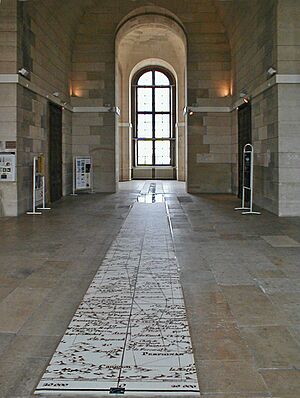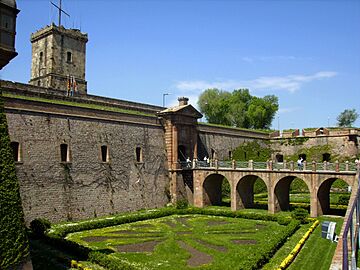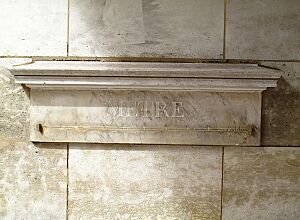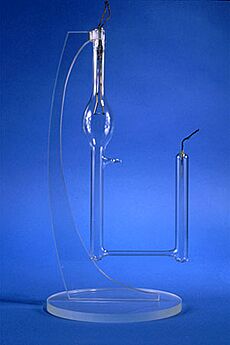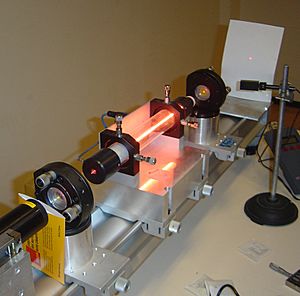History of the metre facts for kids
The metre is the basic unit of length we use today, like when you measure your height or the length of a football field. But how did we decide on its exact length? The story of the metre is a journey through science, revolutions, and amazing discoveries!
For a long time, people used all sorts of different ways to measure length. Imagine trying to build something if everyone used a different "foot" size! Scientists realized they needed a measurement that was the same everywhere and didn't change. They also wanted a system that was easy to use, like our decimal system (based on 10s).
The French Revolution in 1789 was a time of big changes in France. People wanted to replace old traditions, including the messy ways of measuring things. Scientists suggested a new unit called the metre. They decided it should be based on something natural and unchanging: the Earth itself! The metre was first defined as one ten-millionth of the distance from the North Pole to the Equator, measured along a special line passing through Paris.
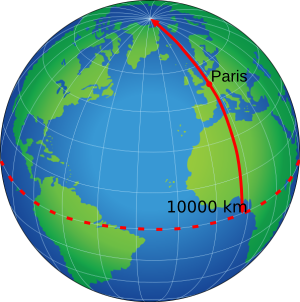
The first official metre was a metal bar called the Mètre des Archives, kept in Paris. Over time, more and more countries started using the metre, especially for science. In 1875, many countries signed the Metre Convention, making the metre an international unit of measurement.
Later, the Mètre des Archives was replaced by new, more precise bars made of a special metal called platinum-iridium. These bars were carefully made and kept in different places around the world.
As science advanced, we found even better ways to define the metre. In 1960, it was defined using the wavelength of light from a special krypton-86 lamp. This meant anyone with the right equipment could create a metre anywhere! Then, in 1983, the definition changed again. Now, the metre is defined by how far light travels in a tiny fraction of a second. This is super accurate because the speed of light is a constant in the universe.
Today, even old units like the yard are officially defined using the metre. For example, a yard is exactly 0.9144 metres.
Contents
Finding a Universal Measure
Long ago, people used parts of their bodies to measure things. For example, the ancient Sumerians used the "cubit," which was the length from your elbow to the tip of your middle finger. The oldest known metal ruler, found in Nippur, was a Sumerian cubit from around 2650 BCE. It was about 51.85 centimetres long.
The Romans had their own "foot," which was divided into 12 "inches." They spread their measurements across their huge empire. After the Roman Empire, many different "feet" appeared in Europe, but they all came from the Roman foot. These feet were often divided into 12 inches, and inches into 12 "lines."
Early Scientific Ideas
Scientists like Galileo Galilei noticed that a swinging pendulum takes the same amount of time to complete a swing if its length stays the same. In 1645, Giovanni Battista Riccioli was the first to measure the length of a "seconds pendulum" – a pendulum that takes exactly one second to swing one way.
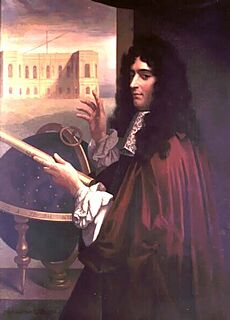
Scientists like Giovanni Domenico Cassini and Jean Picard also worked on measuring the size of the Earth. They used a method called triangulation along the Paris meridian (an imaginary line running from the North Pole to the South Pole through Paris). In 1671, Picard even suggested using the length of a seconds pendulum as a universal unit of measurement.
However, scientists soon found a problem: the length of a seconds pendulum changes slightly depending on where you are on Earth! This is because the Earth's gravity is not exactly the same everywhere. For example, Jean Richer found that a seconds pendulum was slightly shorter in Cayenne, French Guiana, than in Paris. This showed that the Earth isn't a perfect sphere; it's a bit flattened at the poles and bulges at the equator, like a slightly squashed ball.
Despite these challenges, scientists kept working on finding a universal measure. They realized that understanding the Earth's exact shape was key to creating a truly universal unit of length.
Defining the Metre by the Earth's Meridian
The French Revolution finally pushed for a big change in measurements. The French Academy of Sciences formed a group of smart scientists, including Joseph-Louis Lagrange and Pierre-Simon Laplace. They decided that the new unit, the metre, should be exactly one ten-millionth of the distance from the North Pole to the Equator along the Paris meridian.
Why the Paris meridian? It was convenient for French surveyors, and a large part of it, from Dunkirk in the north to Barcelona in the south (about 1,000 km), could be measured accurately. This section was also roughly in the middle of the Earth's quadrant, where the Earth's slight flattening wouldn't cause too many problems for measurements.
The Great Survey
The huge task of measuring this part of the meridian fell to two astronomers: Pierre Méchain and Jean-Baptiste Delambre. This project took more than six years, from 1792 to 1798. It was a very difficult time because of the French Revolution. The surveyors faced many challenges, including being arrested several times! Sadly, Méchain even died from yellow fever while trying to improve his measurements in Spain.
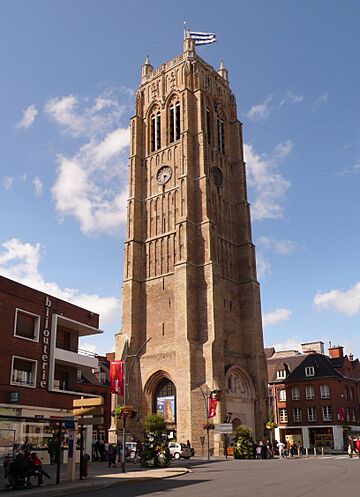
Delambre measured the northern part, from Dunkirk to Rodez Cathedral. Méchain measured the southern part, from Rodez to Montjuïc Fortress in Barcelona. They used special tools like the "repeating circle," invented by Jean-Charles de Borda, which helped them measure angles with much greater accuracy.

In late 1798, Delambre and Méchain returned to Paris with all their data. Scientists from many other countries joined a French commission to check their work. Based on these measurements, the official length of the metre was set.
The First Metre Bar
After the survey, a physical bar was made to represent the metre. This was the Mètre des Archives, a platinum bar kept in Paris. It served as the official standard for many years.
The International Prototype Metre
After the Napoleonic Wars, many countries in Latin America and Egypt started using the metre. In Europe, the metre became more common after the fall of the French empires. By the 1870s, most European countries had adopted the metre.
Scientists realized that to make measurements truly universal, they needed an international standard. In 1867, the European Arc Measurement group called for a new, international prototype metre (IPM). This new metre would be as close as possible to the original Mètre des Archives.
In 1875, the Metre Convention was signed in Paris by many countries. This agreement created the International Bureau of Weights and Measures (BIPM), an organization dedicated to making sure measurements are the same worldwide. The BIPM is located in Sèvres, near Paris, as a nod to France's role in creating the metric system.
Building the New Metre Bars
In 1889, the first meeting of the General Conference on Weights and Measures (CGPM) approved and distributed new, super-accurate metre standards to the countries that signed the Metre Convention. These bars were made of a special alloy: 90% platinum and 10% iridium. This alloy was much harder than pure platinum. They also had a special X-shape to make them very stable.
A company in London, Johnson Matthey, made thirty of these bars. One of them, Bar No. 6, was found to be exactly the same length as the old Mètre des Archives. This bar became the international prototype metre. The other bars were carefully measured against it and then sent to different countries to be their national standards.
These new metre bars were "line standards," meaning the metre was defined by the distance between two lines marked on the bar. This avoided wear and tear problems that could happen with "end standards" (where the length is the entire bar itself).
In 1927, the definition of the metre was made even more formal. It was defined as the distance between the two central lines on the platinum-iridium bar, at 0°C, under standard air pressure, and supported at specific points to minimize bending.
New Ways to Define the Metre
As science progressed, scientists looked for even more precise ways to define the metre, ways that didn't rely on a physical bar.
Using Light Waves
In the early 1900s, scientists like Albert A. Michelson started using light waves to measure length. Light waves have a very specific length, called a wavelength. This was a very precise way to measure things.
By the 1950s, measuring with light waves was the best way to get accurate lengths. The problem was that the metre was still defined by a physical bar, and light waves were measured in a different unit called the ångström. Converting between them added small errors.
The solution was to define the metre using light waves directly. Scientists chose the orange light from a krypton-86 atom. This light was very stable and had a very precise wavelength.
So, in 1960, the CGPM agreed on a new definition: The metre is the length equal to 1,650,763.73 wavelengths in a vacuum of the orange light from a krypton-86 atom.
Using the Speed of Light
Soon after, a new invention changed everything: the laser! Lasers produce very pure, focused light, which is perfect for super-accurate measurements.
Scientists found that the krypton standard had some tiny imperfections. They also learned how to measure the frequency of light (how many waves pass a point per second) very accurately. Since the speed of light is its frequency multiplied by its wavelength, if you know the speed and the frequency, you can find the wavelength (and thus the length).
In 1975, scientists agreed on a fixed value for the speed of light in a vacuum: exactly 299,792,458 metres per second. This was a huge step!
Then, in 1983, the CGPM adopted the most modern definition of the metre: The metre is the length of the path travelled by light in vacuum during a time interval of 1/299,792,458 of a second.
This means that the metre is now linked directly to time, which we can measure incredibly accurately using atomic clocks. This definition is very flexible because it means you can realize a metre using any light source, as long as you know its frequency.
In 2019, this definition was reworded slightly to make it even clearer, but the meaning stayed the same. The metre is the basic unit of length in the International System of Units (SI), and its definition is based on the fixed value of the speed of light.
How the Metre's Definition Changed Over Time
Here's a quick look at how the metre has been defined throughout history:
| How it was defined | When | How accurate |
|---|---|---|
| One ten-millionth of the distance from the North Pole to the Equator (measured through Paris) | 1798 | About 0.1 to 0.5 millimetres |
| The first official platinum bar (the Mètre des Archives) | 1799 | About 0.01 to 0.05 millimetres |
| A special platinum-iridium bar at the temperature of melting ice | 1889 | About 0.1 to 0.2 micrometres (a micrometre is one-millionth of a metre) |
| A special platinum-iridium bar at the temperature of melting ice, under normal air pressure, supported in a specific way | 1927 | (No new accuracy given, just a more formal description) |
| 1,650,763.73 wavelengths of orange light from a krypton-86 atom | 1960 | About 0.005 to 0.01 micrometres |
| The distance light travels in a vacuum in 1/299,792,458 of a second | 1983 | About 0.1 nanometres (a nanometre is one-billionth of a metre) |
Images for kids


